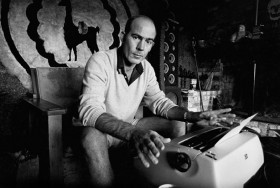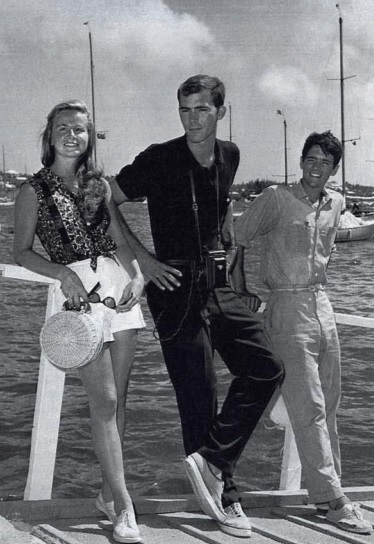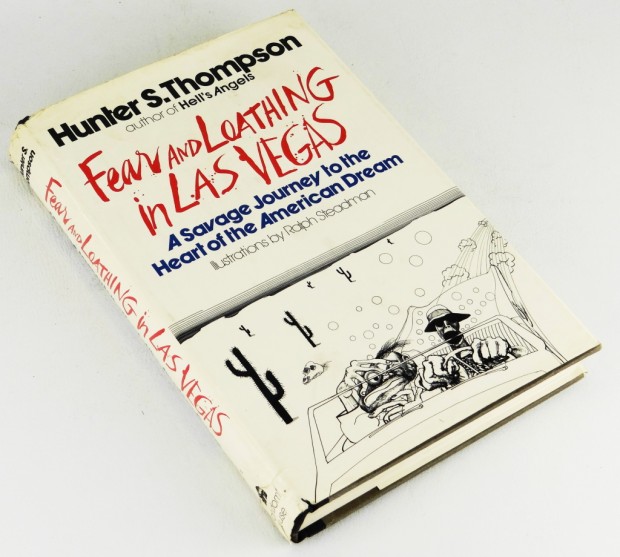Thompson: Fear & Loathing In Bermuda, ’60
 The godfather of what he called “Gonzo journalism” — a rollicking, first-person narrative style which dispensed with traditional objectivity and, very often, with objective facts — Hunter S. Thompson [1937- 2005] remains best-known for his brace of lacerating ’70s comic memoirs, “Fear & Loathing In Las Vegas” and “Fear & Loathing On The Campaign Trail, ’72.”
The godfather of what he called “Gonzo journalism” — a rollicking, first-person narrative style which dispensed with traditional objectivity and, very often, with objective facts — Hunter S. Thompson [1937- 2005] remains best-known for his brace of lacerating ’70s comic memoirs, “Fear & Loathing In Las Vegas” and “Fear & Loathing On The Campaign Trail, ’72.”
But had he overcome his overarching hatred for the island’s officialdom after being stranded here en route to Spain aboard a stricken yacht, the future bestselling author and self-styled “national affairs correspondent” for “Rolling Stone” magazine may well have settled for a career writing press releases about vacationing honeymooners for the Bermuda News Bureau.
Born and raised in Kentucky, after a stint in the US Air Force Dr. Thompson [his doctorate was of the mail-order variety] was a man of sometimes disorientingly manic action as well as a man of letters; he was the sports editor for the “Middletown Record” in New York in 1959 before being fired for destroying a candy machine that had eaten his nickel.
He then moved to Puerto Rico to write for the “San Juan Star” — an experience which informed his novel “The Rum Diary” [written in the 1960s but not published until 1998]– before crewing aboard a boat intended to take him, girlfriend Sandy Conklin and friend Paul Semonin to Spain.
But they found themselves marooned in Bermuda after their yacht limped in here in the summer of 1960 following a storm.
The trio initially lived in caves, stealing cabbages out of gardens to eat.
A local newspaper ran a front-page, photo article on their plight that included the revelatory quote: “Why settle down so early in life? There is meaning somehow in all this, but right now it’s a little hard to find.”
Dr. Thompson continued: “It’s a queer place to be stranded. When I think of all the people back in the States who would really enjoy being stranded in Bermuda for a while, I really can’t take our plight very seriously.”
Hunter Thompson, Sandy Conklin and Paul Semonin at the Royal Bermuda Yacht Club in 1960
But his time in Bermuda wasn’t as carefree as he suggested in the newspaper interview.
Near broke and with no immediate prospects of finding a job in the US, Dr. Thompson applied for a position with the Bermuda News Bureau and was promptly turned down because he lacked a work permit; the promotional arm of the Trade Development Board — precursor to the Tourism Ministry — the Bermuda News Bureau specialised in distributing reports on local sporting and cultural events along with photos of visiting celebrities and honeymooners to national and local media outlets in the US and Canada.
“If I could think of a way to do it right now, I’d head back to Louisville, sit on the porch drinking beer, drive around Cherokee Park for a few nights, and try to sink back as far as I could into the world that did its best to make me,” a homesick Dr. Thompson wrote to a friend from Bermuda on July 2, 1960. “It’s not hard to get tired of interminable palms and poinciana, and I could do at the moment with a single elm tree on a midnight street in the Highlands.”
While he had begged rent-free accomodation for himself and his future wife from a local acquaintance, his friend Mr. Semonin continued to sleep in the rough throughout the unanticipated Bermuda interlude.
In another letter, Dr. Thompson wrote:
“This Bermuda thing has been a nightmare of gargantuan proportions … Semonin slept in a public park — taking a shower each morning at the Royal Bermuda Yacht Club — and Sandy & I have been sleeping in a basement on the outskirts of Hamilton. All efforts at departure have failed. The Britishers have threatened to deport us and take it as a tremendous joke that three young Americans are starving on the streets of Hamilton. They refuse to let us work [immigration] & they tell us we have to get out immediately. Lack of funds is a crime here and they have hounded us unmercifully.”
When relatives finally sent him money and a new passport, Dr. Thompson and his fiancee left the island and he abandoned tentative plans to re-apply for work here once he had returned to the US — although he memorialised his accidental stay in Bermuda in the short story “Buried At Sea” which was published in the December, 1961 issue of “Rogue” magazine.
Eventually settling in Woody Creek, Colorado, Dr. Thompson became known internationally renowned with the publication of his book “Hell’s Angels: The Strange and Terrible Saga of the Outlaw Motorcycle Gangs” [1967], for which he had spent a year living and riding with the Angels, experiencing their lives and hearing their stories first hand.
Previously a relatively conventional journalist, with the publication of his pioneering Gonzo-flavoured “The Kentucky Derby Is Decadent and Depraved” in “Scanlan’s Monthly” magazine he became a major counter cultural figure.
The work he remains best known for — and which most perfectly exemplifies his Gonzo style — is “Fear and Loathing in Las Vegas: A Savage Journey to the Heart of the American Dream” [1972], a rumination on the failure of the 1960s counterculture movement.
Politically minded, Dr. Thompson ran unsuccessfully for sheriff of Pitkin County, Colorado, in 1970, on the Freak Power ticket [his campaign manifesto included pledges to "rip up all city streets with jackhammers and sod the streets at once" and to "change the name Aspen to Fat City. This would prevent greed heads, land rapers, and other human jackals from capitalizing on the name 'Aspen'. These swine should be ...broken, and driven across the land."]. He shaved his head bald during the campuign, referring to the crew-cut Republican incumbent — who only narrowly defeated him –as “my long-haired opponent.”.
He was well known for his inveterate hatred of Richard Nixon, who he claimed represented “that dark, venal, and incurably violent side of the American character” and whom he meticulously dissected in what many consider to be his greatest contribution to American letters, “Fear and Loathing on the Campaign Trail ’72″, which first appeared in “Rolling Stone” as a series of dispatches on the 1972 Nixon/George McGovern presidential race.
Dr. Thompson’s output notably declined from the mid-1970s, as he struggled with the consequences of fame, and he complained that he could no longer merely report on events as he was too easily recognised. He was known also for his lifelong use of alcohol and illegal drugs; his love of firearms, and his iconoclastic contempt for authoritarianism, and remarked that, “I hate to advocate drugs, alcohol, violence, or insanity to anyone, but they’ve always worked for me.”
While suffering a bout of health problems, Dr. Thompson committed suicide at the age of 67.
As per his wishes, his ashes were fired out of a cannon in a ceremony funded by his friend, Johnny Depp — who portrayed him in the movie versions of “Fear & Loathing In Las Vegas” and “The Rum Diary” — and attended by a host of friends including then Senator John Kerry and the actor Jack Nicholson.
British Novelist Hari Kunzru wrote that, “the true voice of Thompson is revealed to be that of American moralist … one who often makes himself ugly to expose the ugliness he sees around him.”
1978 BBC documentary on Hunter S. Thompson and his collaborator, artist/cartoonist Ralph Steadman
Read More About
Category: All, Entertainment




BERMUDA Immigration failed again could have had a resident that far surpassed stardom Hunter was a legend and will always be viewed in that light long after his death…
Thank you for the Article Bernews. No thanks to then government for not seeing potential when it smacks you in the face…
Typical of Bermuda and it’s many pathetic ways,even today it’s the same.
What was wrong with the American Embassy at the time, never mind the ‘Britishers’ who allegedly failed you. This smacks of an arrogant young man and I would interested to hear the official side of the story!